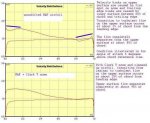Check this thread. Rotor damping is discussed in detail.
http://www.rotaryforum.com/forum/showthread.php?t=18121&highlight=rotor+damping
I have been able to analyze an RAF rotor blade section and was surprised at how good it was. The CG is almost exactly on the ¼ chord line and pitching moment coefficient is nearly zero. The only real negative was that the leading edge portion had some lack of fairness that increased the drag. I have the computer plots around here somewhere.
Nearly all gyros follow Bensen’s lead and use the NACA 8H12 airfoil section. Both Bensen and Sportcopter took some liberties and flattened out the lower surface. DW rotors are about the only serious brand which does not use the 8H12.
http://www.rotaryforum.com/forum/showthread.php?t=18121&highlight=rotor+damping
I have been able to analyze an RAF rotor blade section and was surprised at how good it was. The CG is almost exactly on the ¼ chord line and pitching moment coefficient is nearly zero. The only real negative was that the leading edge portion had some lack of fairness that increased the drag. I have the computer plots around here somewhere.
Nearly all gyros follow Bensen’s lead and use the NACA 8H12 airfoil section. Both Bensen and Sportcopter took some liberties and flattened out the lower surface. DW rotors are about the only serious brand which does not use the 8H12.





